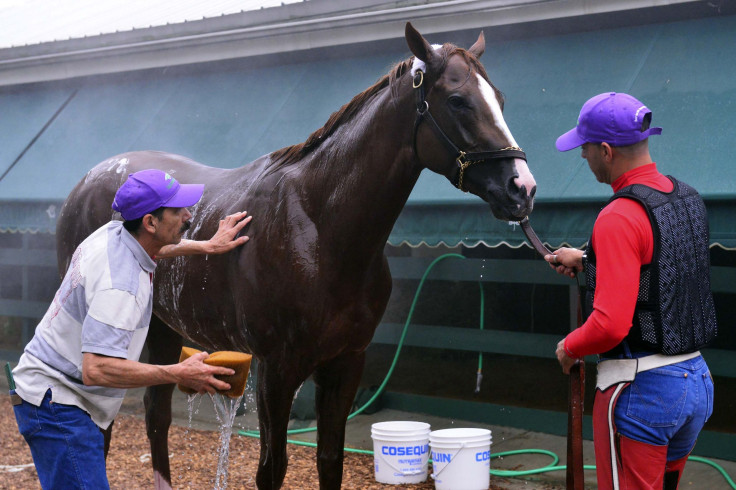Preakness 2014: California Chrome Cost $10,000, But What's The Real Cost Of A Racehorse?

The owners of California Chrome, the Kentucky Derby winner who’s a favorite in Saturday’s Preakness Stakes, bred the colt for just $10,000.
And if that were all it cost to run a racehorse, you and I could be standing in the Winner’s Circle too. But taking a championship-caliber thoroughbred along the way to the biggest races in the world is a dauntingly expensive journey.
“There’s nothing but cost that goes into it,” said Frank Vespe, founder of TheRacingBiz.com. “Horse racing is populated by people who are bad at math.”
The arithmetic turned out well for Steve and Carolyn Coburn, and Perry and Denise Martin, who invested $10,000 to breed mare Love the Chase to sire Lucky Pulpit. Now California Chrome may be worth more than $12 million.
According to Vespe, who has 30 years of experience as a handicapper and horse owner, a third of the horses bred to race never make it to the track; and a third of the horses left never win. Owners pour small fortunes into their thoroughbreds with absolutely no guarantee of a return or profit. Vespe said it could cost an owner upwards of $30,000 just to get a horse to the track for the first time.
After the horse is bred, an owner must stable it. That could run close to $1,200 a month even at the owner’s farm. Fees for a veterinarian vary but can reach as high as $250 a month, and horses must be fitted for new shoes every month, costing $150 per visit from the farrier or blacksmith.
The horse won’t even begin basic training until about three months into its first year, and much of that time is devoted to familiarizing the horse with people while testing its intelligence.
“From the time that horse hits the ground, you want him to be comfortable around humans,” said Sean Clancy, owner of Riverdee Stable and ThisIsHorseRacing.com. “It’s just like being in the classroom. You have the ‘brains,’ the ‘pothead,’ ‘lazy ones.’ They’re just like people, and you get a good sense pretty early if the horse is going to be good.”
At the age of two, a horse then goes to the track and begins more advanced training. Art Sherman, who at 77 is the oldest trainer ever to win at the Kentucky Derby, charges fees that range from a 10 to 13 percent cut of the winnings from a stakes race. At the Derby, California Chrome earned $1.4 million, which netted Sherman roughly $140,000.
A jockey is usually paid a mounting fee or 10 percent of the winnings. That’s another $140,000 shelled out to veteran jockey Victor Espinoza for riding California Chrome to victory at the Derby.
Before trotting out to any of the Triple Crown races, a horse must be nominated: That comes with a fee of $600 if it’s submitted by the end of January, or $6,000 until the end of March. Then there are the entry and starting fees. At Churchill Downs, the entry and starting fee is $25,000 each, and at the Preakness and Belmont they dip slightly to $15,000.
Owners and trainers must also obtain licenses for each state they race in. In California Chrome’s case, that could be as many as four states including California, Kentucky, Maryland and possibly New York for the Belmont.
Don’t forget that you have to transport the horse from race to race. Clancy said the cost hovers around $5,000 per trip. After the Derby win, Coburn said his horse would head to Maryland for the second race of the Triple Crown. “He’ll fly first class,” Coburn said, “and me and the wife will fly coach again.”
Insurance? That ranges from 4 to 6 percent of the horse’s estimated value. It’s unlikely that California Chrome’s owners took out a policy until very recently. California Chrome’s rise in value parallels his rise to fame. Depending on how the race goes on Saturday, the horse could be at his peak value right now.
Two months before the Derby, the Coburns and Martins passed on the opportunity to not only recoup their expenses but make a huge profit, turning down a reported $6 million offer for a controlling 51 percent interest in California Chrome. The offer is largely the reason the 3-year-old colt’s estimated value sits at about $12 million. It would rise if he claims the second jewel of the Triple Crown on Saturday, along with the $1.5 million purse.
Equivalent to doubling down at the blackjack table, the Coburns and Martins are banking on their dreams and faith in California Chrome. It’s a desire and hope commonplace in horse racing.
“Rule of thumb is, if you’re in it for business purposes, you pretty much always say ‘yes,’” Vespe said. “If someone wants to buy your horse [for] more than what you pay for it, you take it.”
“All of us who own horses are in it for the dream. It ends up being not what the horse is worth. It’s what your dream is worth.”
© Copyright IBTimes 2025. All rights reserved.





















